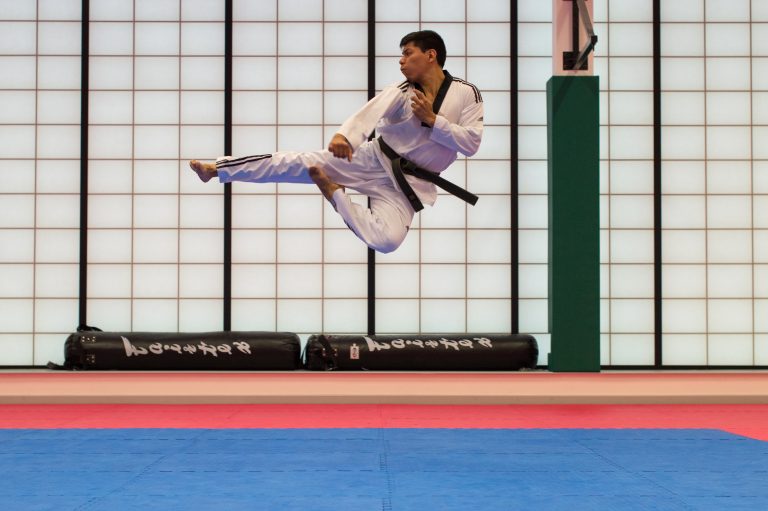What is Meant by Karate Belt?
Karate is a martial art that has its roots in Okinawa, Japan. It is an art form that is based on self-defense techniques, where one can use their whole body as a weapon to defend themselves against an attacker. In karate, belts are used to denote the level of expertise and skill of the karate practitioner. The color of the belt also signifies the advancement of the student. In this blog post, we will discuss in-depth what a karate belt is, the different colors of karate belts, and what each color signifies.
What is a Karate Belt?
A karate belt is a piece of cloth that is worn around the waist of a karate practitioner. The belt can range in color from white to black and is used to signify the level of expertise of the practitioner. When a student starts their journey in karate, they are given a white belt, which is the beginner level. As the student progresses, they get promoted to different colored belts, indicating their journey towards mastering the martial art form.
What are the Different Colors of Karate Belts?
There are several colors of karate belts awarded based on the level of skill and expertise of the student in karate. Here is a list of different colored belts, in the order of advancement:
White Belt
A white belt is the beginner’s level, and it is awarded to someone who has just started their journey in karate. The white belt signifies innocence, purity, and an eagerness to learn.
Yellow Belt
A yellow belt is awarded to a student who demonstrates an understanding of the basic fundamentals of karate, such as stances, punches, and kicks. The yellow belt indicates the beginning of the student’s journey towards a more advanced level.
Orange Belt
The orange belt signifies a student’s growth in strength and knowledge of karate fundamentals. The student is starting to develop a sense of control over their movements as they advance towards the green belt level.
Green Belt
A green belt indicates the growth of a student’s skill in karate. The student has demonstrated a solid foundation of knowledge in karate techniques and is ready to move towards the advanced levels of the martial art.
Blue Belt
A blue belt signifies that the student has progressed to an advanced level in karate. They have a deep understanding of the fundamental techniques of karate and are beginning to understand the more difficult techniques.
Purple Belt
The purple belt is awarded to a student who has demonstrated exceptional skill and knowledge of karate techniques. The student has a deep understanding of the art form and is a leader in their class.
Brown Belt
A brown belt is awarded to a student who is an expert in karate. They have a complete understanding of karate techniques and have perfected their movements. This level is only the beginning of the more advanced levels.
Black Belt
The black belt is the ultimate symbol of achievement in karate. It signifies that the student has achieved mastery over the art form and is now qualified to teach karate to others.
What is Meant by Karate Belt: Answering the Most Frequent Questions
Karate is a traditional martial art that originated in Okinawa, Japan. It has become a popular sport globally, with millions of practitioners worldwide. When you enroll for karate classes, you will notice students in different colored belts. The karate belt system is quite intriguing, and it raises many questions among beginners. In this guide, we answer the most frequent questions on the topic.
What is the Karate Belt System?
The karate belt system comprises of a range of colored belts that signify the level of expertise of a student. The belts are ranked in increasing levels of expertise – from white to black. The rankings are not only based on physical abilities but also on mental and personal development. Each level has its unique curriculum and standards.
What Do the Different Belt Colors Signify?
In Karate, the color of the belt represents the level and ranks of a student. Here is a breakdown of what each color signifies.
White Belt
A white belt is where every karate journey starts. It signifies purity and innocence. It is a blank canvas that represents the student’s willingness to learn.
Yellow Belt
The yellow belt represents the growth and progress of a student. It signifies that the student is starting to build on the foundations learnt as a white belt.
Orange Belt
The orange belt signifies that the student is starting to master the basics of karate. It shows the enthusiasm and commitment of the student to learn and develop.
Green Belt
The green belt signifies that the student is showing a deeper understanding of karate techniques and skills.
Blue Belt
The blue belt represents the sky and signifies the broad and vast potential of the student in karate.
Purple Belt
The purple belt represents the student’s maturity in karate – both physically and mentally. It showcases the student’s determination to advance to higher levels.
Brown Belt
The brown belt represents the deepening of a student’s understanding of karate. It signifies the student is highly skilled and committed to reaching the black belt level.
Black Belt
The black belt is not just the highest rank in karate but also means that the student is highly skilled, experienced, and mentally mature. It shows the commitment, discipline, and mastery of karate. It is worth noting that there are ten levels of black belt, known as „Dans.“
How Long Does it Take to Earn a Black Belt?
Earning a black belt takes time and dedication. The length of time it takes to earn a black belt depends on several factors, including the student’s training consistency, frequency, and effort. It typically takes three to five years for someone to earn a black belt. However, this timeline can vary depending on the student’s natural talent, passion, age, and skill level.
Can I Skip Levels When Advancing Up The Belt System?
No, you cannot skip levels in the karate belt system. Karate requires that students move through the different ranks and levels, as each level has a particular curriculum and skills that must be learned.
How Are Belt Tests Conducted?
Belt tests enable students to progress from one level to the next. To qualify for a belt test, students must have trained for a minimum of three months, and their instructor must approve them for testing. A panel of black belts and senior students evaluates the students during the test. Students display their knowledge and proficiency in a range of techniques and kata, among other things.
What Happens After I Earn My Black Belt?
Earning a black belt is a great achievement, but it is not the end of your karate journey. After earning a black belt, you enter the world of „Dans.“ Each Dan represents ten years of training and dedication. Advancing through the Dans requires more substantial commitment to karate and mastery of its principles.
What is meant by karate belt?
Karate is a martial art that originated in Japan and has gained immense popularity worldwide. A karate belt is an essential accessory that represents a student’s level of expertise in martial arts. The belt color indicates the student’s progress in learning karate, and it represents the student’s skill level, dedication, and commitment to the art.
How did the concept of karate belts come to be?
The concept of karate belts dates back to the early 20th century when Gichin Funakoshi introduced karate to Japan. During his time, there were no standardized training methods, and students would wear any belt they had available. Funakoshi introduced a series of colored belts to indicate a student’s level of skill and commitment to the art.
The origins of the different types of belts can be traced back to the practice of Japanese samurai warriors. In those days, a student’s martial arts training was indicated by a rope tied around the waist of their gi, or training uniform. The color of the rope indicated their rank, with white being the lowest and black being the highest.
What do the different colors of karate belts indicate?
Karate belts are usually made of cotton and come in different colors. The colors and their meanings may vary slightly depending on the specific karate style, but generally, the following colors and their meanings are recognized:
White belt
A white belt is the starting belt, indicating that the student is a beginner and has little or no experience with karate. The white belt represents the seed, which has the potential to grow into a mighty martial arts practitioner.
Yellow belt
A yellow belt indicates that the student has made some progress and has started to understand the basic techniques of karate. It represents the rising sun and the growth of a new beginning.
Orange belt
An orange belt signifies growth and is usually awarded to students who exhibit strong commitment and a willingness to learn. Students who earn the orange belt have a better understanding of the different techniques and are usually asked to participate in more advanced training.
Green belt
A green belt represents a solid understanding of the basic karate techniques and is considered the midway point in a student’s karate journey. Green belt holders are expected to mentor and train junior students.
Blue belt
A blue belt represents the expansion of the student’s knowledge and skills beyond basic techniques to include more advanced ones. It represents the skies, the vast area that a student can cover with their newfound skills.
Purple belt
A purple belt is considered a significant milestone in a student’s karate journey because it requires a significant amount of dedication and hard work. Students must exhibit excellent technique, control, and determination to earn a purple belt.
Brown belt
A brown belt is awarded to students who demonstrate mastery of the essential karate techniques. It signifies the student’s ability to use those techniques in real-life combat situations.
Black belt
A black belt is considered the highest ranking belt and signifies mastery of the art of karate. It takes years of dedication and rigorous training to earn a black belt. Black belt holders are expected to teach junior students, uphold the virtues of karate, and act as role models in the karate community.
Conclusion
In conclusion, karate belts are an essential aspect of martial arts training. They serve as a visual representation of a student’s karate journey, progress, and hard work. Students should not focus solely on the belt color but instead, strive to understand the underlying principles and techniques that make up the art of karate. The journey to earning a black belt is a long and difficult one, but it is a testament to one’s commitment, discipline, and determination.
Inhaltsverzeichnis






